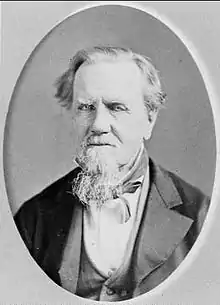William Henville Burford
William Henville Burford (24 January 1807 – 23 October 1895) was an apprenticed butcher with some experience as a tallow merchant and chandler in Cannon Street, St George's East, in the East End of London. In 1838 he emigrated to South Australia for his health's sake with his wife and three daughters on the Pestonjee Bomanjee, arriving at Glenelg on 11 October.[1] Initially he found work as a painter and glazier, and soon had one of the larger businesses in the Colony.[2] In 1840, when a recession had made those trades unprofitable, he was able to start a soap and candle factory, W. H. Burford & Sons, in 134 (154?) Grenfell Street.[3] The business failed several times, but revived with the opening of the Burra copper mine in 1848, then the Moonta and Wallaroo mines around 1863.[4]

Burford was an alderman of the Adelaide Town Council for 1840 and 1841. During his second term he earned the nickname of "ninepenny dips" for his proposal to more than double the council rates to that figure (and "dip" being a form of candle), and was reviled for proposing other stringencies.[5] He was not elected the following year and was vindicated when the Council collapsed, bankrupt.
Burford was elected to the South Australian House of Assembly for the seat of City of Adelaide in 1857.[6][7] He was prominent in debates and a strong supporter of Robert Torrens' Real Property Act, but resigned in 1859.
Burford was a devout churchgoer, worshipping with the Independent Baptists, then Scotch Baptists and finally the Unley Church of Christ.[4]
Family of W. H. Burford
He married three times:
- Elizabeth Messent (c. 1814 – 14 July 1858) in May 1833[4]
- Children:
- Elizabeth "Edith" Burford (c. 1832 – 28 January 1900)[8]
- m. Charles Bowen (c. 1834 – 5 September 1870) on 10 April 1857; their eldest son F. A. "Arthur" Bowen became manager of Burford & Sons.
- m. Rev. R. K. Finlayson (27 April 1839 – 27 March 1917) on 19 August 1884 (his first wife, also Elizabeth, died 1880[9])
- Ann Burford second daughter (c. 1837 – 1 April 1852)
- Sarah Burford (died 1838 on voyage)
- Gertrude Burford (c. 1841 – 18 August 1914) married Robert Eddy 10 September 1885
- Benjamin Burford (c. 1843 – 18 May 1905) married Mary Jane Ware (died 24 July 1930) on 24 May 1866. He died, aged 65, from a self-inflicted gunshot after suffering head pains and deafness for seven years.[10] He had only five years previously built a large house "Attunga" on 4.5 acres (1.8ha) at 120 Kensington Road, in what was then Rose Park.[11]
- William Burford (11 December 1845 – 6 March 1925) who oversaw the greatest development of the company
- Elizabeth "Edith" Burford (c. 1832 – 28 January 1900)[8]
- Mary Ann Messent (c. 1815 – 22 September 1879), (sister of first wife Elizabeth Messent), on 31 October 1861
- Frances Sarah Ann Hawkes, née Symonds, the widow of John H. M. Hawkes (c. 1827 – 14 October 1858) in 1880.[12]
References
- Diane Cummings. "Bound for South Australia: Passenger Lists 1836-1851". State Library of South Australia.
- "Messrs W. H. Burford & Co's (sic) Jubilee". The Advertiser. 4 November 1890. p. 6. Retrieved 8 July 2011 – via Trove.
- "Mr. W. Burford – a Large-Hearted Citizen". The Register. 7 March 1925. p. 13. Retrieved 4 July 2011 – via Trove.
- Burford, William Henville Taylor, Herbert R. Australian Dictionary of Biography online accessed 8 July 2011
- "Hindmarsh Ward — The Vacant Seat of Alderman". South Australian Register. 15 August 1854 – via Trove.
- "The Parliament". South Australian Register. 6 May 1857. p. 4. Retrieved 7 July 2011 – via Trove.
- "William Henry Burford". Former members of the Parliament of South Australia. Retrieved 12 November 2022.
- "Concerning People". South Australian Register. Vol. LXV, no. 16, 602. South Australia. 29 January 1900. p. 5. Retrieved 26 April 2019 – via National Library of Australia.
- "Family Notices". South Australian Register. 16 October 1880. p. 2. Retrieved 21 July 2011 – via Trove.
- "Death of Mr. Benjamin Burford". Kalgoorlie Western Argus. 23 May 1905. p. 30. Retrieved 22 August 2011 – via Trove.
- In 1944, Otto von Reiben donated the 4.5 acre property "Attunga" to the City of Burnside for a hospital now named the Burnside War Memorial Hospital, in what is now known as Toorak Gardens – Darren Young and Chris Marks, "Landmarks of Burnside" (PDF). Archived from the original (PDF) on 14 October 2009., Celebrating our city – 150 years, City of Burnside, August 2007, page 51
- "Obituary". The Chronicle. 22 February 1902. p. 33. Retrieved 3 October 2013 – via Trove.